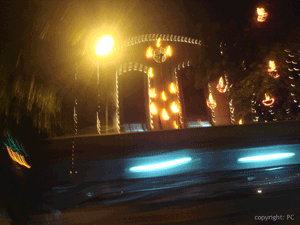But modern day lights have taken over the festivities with its psychedelic colours and varieties of light displays. No fuss, no oily mess to deal with, no fear of flames being blown away by the wind, electric lights are a convenience here to stay. It has changed the face of the festival and how?
Busy streets lined with jewellery stores selling the most sought after metal - gold, almost an obsession during Diwali (textured photos). The greater the competition among them to attract attention with bigger & brighter displays each year.

Diya (lamp) - shaped electric lights strung on a tree in front of a high-street store

Diya (lamp) - shaped electric lights strung on a tree in front of a high-street store
The new diyas or clay lamps are generally bought in advance and soaked for a few hours in water to reduce the absorption levels of the clay. When oil is poured it stays in the lamp and does not get absorbed by the porous nature of the clay. Whereas, all it requires is for the electric lights to be taken out of storage, given a good dusting, strung on railings, balconies, trees & shurbs and plugged in. Reusable, year after year. Unlike, clay lamps which if used one year cannot be reused the next year as per tradition.
Traditions do evolve over time but one cannot help but feel a sense of nostalgia for the earthy, tiny, diyas which are fast becoming just token symbols of the festival.


